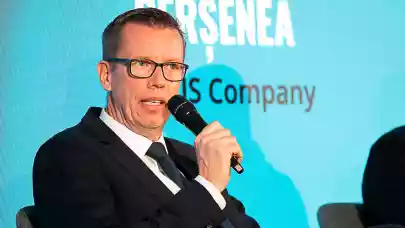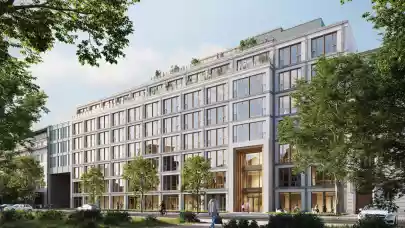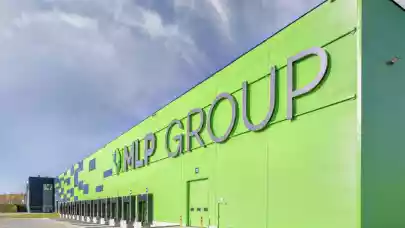
On the financing side, there is still demand for lending towards logistics. Maarten Otte, Head of Investor Relations at CTP, talked to Property Forum at Expo Real about financing conditions and the developer’s ambitious plans for the future.
We’re here at Expo Real, I’m sure you’re meeting a lot of clients. What is the overall market sentiment that you’re getting?
On the financing side, we see that there is still demand for lending towards logistics. First, banks are looking for standing portfolios and we can offer these. It's much easier for a bank to underwrite a standing portfolio rather than an in-development project. Secondly, they look for diversified portfolios, which we also can provide. Banks do not want to lend money to one big building with a single tenant – it is just too risky. They prefer to lend to one of our parks, where we have 20, or in some cases even 50 or more tenants. And finally, the banks want to have a partner with a track record. It's easier for a financial institution to lend to a company with experience in operating assets, especially in the current market conditions, rather than to funds which may have only financial-driven motives and are not long-term holders.
We are observing sufficient demand this year - we have signed over €1 billion of loan facilities for CTP. Roughly €560 million of that is unsecured and the remainder is secured. We see the depth of both the unsecured and secured bank lending market and we are able to borrow at or in the low 200 bps in terms of spreads. So we are able to get competitive pricing, and we will continue to rely on the bank market in the coming months as it's still slightly more attractive than the bond market. Spreads in the bond market have come down quite a bit though, if you look at the last months. So the bond market is starting to look more rational than it has been in the last one and a half years.
When do you expect it to be a more attractive choice again?
We hope to be able to go back to the bond market next year. We'll see how things play out. We had some promising conversations with our bondholders during the last few weeks.
You mentioned that it's easier to get a loan for a standing portfolio. How would you summarise the situation for development loans right now?
The reason why you see supply in certain markets coming down is that some developers have issues with development financing because development financing banks are more limited and the interest will be higher. Ultimately, we are confronted with these higher costs as well, but we can better cope with them in our model. We finance our developments with equity, and then when they are ready, we refinance them. That system allows us to basically lock in a lower cost of debt and therefore improves our competitive advantage in the current market.
CTP has recently heavily expanded into the Western European market. How has that affected the availability of banks for potential financing?
Most of our secured financing is still in our core markets because they have big, standing portfolios. We started to do some financing in Poland, where we are dynamically expanding nowadays. And as I explained before, we mostly finance standing portfolios. So if you look at where we have secured financing, it's mostly in our core legacy markets, where we have already that product. We might look at one point in time in Germany, but we haven't at this stage. We have also completed some secured financing in the Netherlands on some assets. If you look at margins in the Netherlands, you will be able to get high hundreds in terms of spreads, while the same figure in the Czech Republic will be 200 and in Romania it will be 230-250. So you see some differences there in terms of costs of funding, but at the same time, your cash flow in Romania will be higher because you have a higher yield.
On which markets does CTP’s expansion strategy currently focus on?
Speaking of the development pipeline, we have currently 1.8 million square metres under construction. Just under a third of it is in the Czech Republic which we continue to see as a very strong market and a very important part of our expansion strategy. Vacancy there remains very low, about low 1%. We are the market leader there with a 28% market share. Next to that, the second biggest expansion market is going to be Poland. We have roughly 450,000 square metres of new construction there. We entered the Polish market just last year and in terms of the pipeline, we are currently the second biggest developer there after Panattoni. Our market share is of course still small, as the Polish market is simply bigger – it is the third largest real estate market in continental Europe. But over time, we want to play a bigger role there, we want to be one of the top three developers in Poland and - over time - one of the top three owners.
In which business sector are tenants expanding the most? Is it still all about nearshoring or it has died down a bit recently?
Up to August, we signed 7% more leases than we did last year. And the average rent per square metre was 11% higher so we continue to see healthy, strong demand. It comes from different sectors, and nearshoring is one of them. If you look to production companies, they think 5-20 years ahead. The nearshoring trend for more decentralised production that we are seeing is just the beginning of that process because it's not that easy for production companies to simply open a new location. The global manufacturers often go to Mexico and Texas for the North American market, Central and Eastern Europe for the European market and they have China for the whole Asia and beyond. Nearshoring is an important factor, especially for the CEE countries, but not the only one. Looking at the last 18 months, manufacturing accounts for close to a third of the leases that we are signing. This year we’re also observing the continued demand from the 3PL sector.
It is worth remembering that the demand is the simple outcome of economic growth. If you look at the CEE region, these countries are outpacing the European average in terms of GDP growth. It leads to the development of the middle class, which leads to an increase in purchasing power, which leads to further acceleration of the market’s growth. That comes with the professionalisation of supply chains, you see also more demand from retail players. Some of the big lease deals that we have signed in the last 18 months were with retail players, not only online ones but also traditional retailers with a more omnichannel approach.
You mentioned the strong rental growth over the last year. How long do you think that will last?
In general, we expect to continue to have strong rental growth, also partly driven by inflation. The Czech market, for example, has been able to grow rents quite substantially in the last four years. Next year, the rate of growth might be slightly lower, because the growth this year has been very substantial. In Poland, the market rental growth last year was also one of the strongest at 30-40%. Poland came from a very low base but is now about €4.5-4.75 per sqm. If you compare it to the Czech Republic, it's cheap, but the growth was substantial in 2022 and we expect it to continue in 2023 and beyond.



